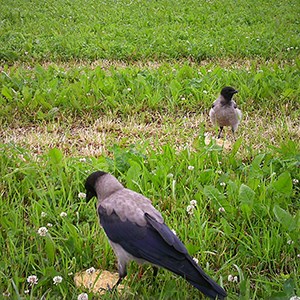Diana Rubene and her colleagues at SLU conducted research in this relatively new field – i.e. how birds use volatile signals (smells) sent out by plants. The SLU researchers are exploring the role of plant volatiles in bird, crop and insect interactions in the agricultural landscape around Uppsala, Sweden. To study this they used an experiment where wild birds – mainly crows, magpies, jackdaws, starlings and thrushes – in crop fields could choose from different petri dish options in their search for food. These dishes contained food (crickets and mealworms), but one of them also contained a plant volatile (methyl salicylate). It didn't matter whether the food was visible or hidden in the dishes, the birds still preferred to forage where the plant volatile was also present.
"We used remote cameras and saw that the birds usually went first to the petri dish that also contained the volatile", says Diana Rubene, researcher at SLU.
The plant volatile that the researchers used is emitted by cereal crop plants when they are attacked by aphids. The study suggests that the birds used the odour as a signal telling them that insect food was probably present.
"That the volatiles were an important cue when the food was not visible is interesting, but the biggest surprise was that the sense of smell played such an important role also when the food was there in front of their eyes. We had guessed that if the birds saw food in all petri dishes the odor wouldn´t matter", says Diana Rubene.
One of the petri dishes smelled of citrus so that the researchers should be able to rule out that the birds were attracted to any odour. But the birds didn´t seem to care at all about the citrus scent.
"We have recorded which petri dish the birds arrived at first. After that they ate everything they could find of course. They are intelligent", says Diana Rubene.
The researchers also tested bird preferences when they could choose between visual cues or olfactory cues – visible plastic spiders or an empty dish with only the plant volatile. Then the birds chose the visible fake food. And that also seem like the safest bet – even if it must have been a disappointment for the birds in this experiment.
These common birds, e.g. corvids and thrushes, are an important part of the ecological interactions in the agricultural landscape. They eat the natural enemies of aphids and can therefore affect how well biological control works in the field, but they also eat different sorts of insect pests. The presence of these birds could therefore, from a human point of view, have negative or positive effects for agriculture.
"This knowledge improves our understanding of birds and their effects on agriculture and biocontrol. But we need more research to see the whole picture", says Diana Rubene.
More information
Contakt person
Diana Rubene, researcher
Department of Crop Production Ecology
Swedish University of Agricultural Sciences
diana.rubene@slu.se, +46 (0)18-67 23 77
Scientific article
Diana Rubene, Malin Leidefors, Velemir Ninkovic, Sönke Eggers, Matthew Low. Disentangling olfactory and visual information used by field foraging birds. Ecology and Evolution, 2019;9:545–552.
https://onlinelibrary.wiley.com/doi/pdf/10.1002/ece3.4773
Press image
(May be published without charge in articles about this press release, please acknowledge the photographer.)
Two crows have found the experimental site. Photo from a surveillance camera. Source: SLU
